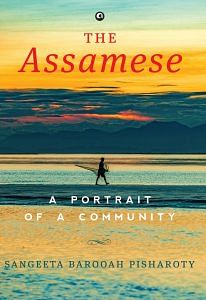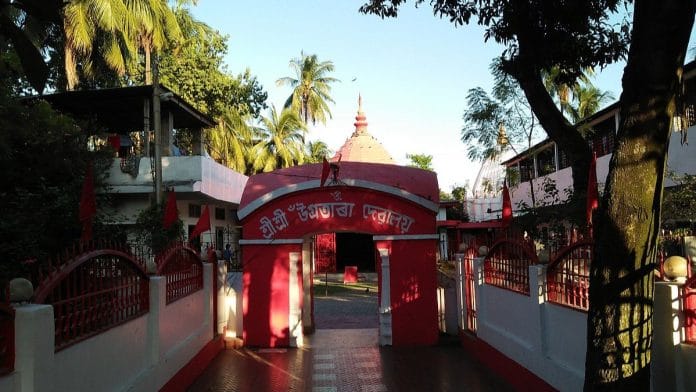Khisiri in Assam is served as a special praxad, blessed handout, to believers gathered at a temple. Though the Assamese are believed to have been introduced to khisiri after coming in contact with the Muslim invaders in the medieval era, one is not sure when the dish crept into the Hindu temples to be served as praxad to the devotees. Anyway, often, a call on whether the khisiri should be vegetarian or otherwise at some temples in Assam is taken depending on what is offered by the devotees to the goddess that day.
At Guwahati’s Ugra Tara temple, fish curry over steamed rice is regularly served as praxad since devotees offer fish to the deity. That night at the Kali Puja in the Nabagraha Temple in Guwahati, a sizeable group of goats, ducks, and pigeons were sacrificed to the goddess in quick succession to the deafening sounds of bell metal chimes and uruli, the ululating sound made by women in eastern India in commemoration of the deity worshipped or to usher in good fortune.
I had joined the congregation on the condition that my extended family would neither force me to watch the horrific sight nor to eat the khisiri prepared with the meat of the sacrificed animals. As a child, I had once locked eyes with the head of a freshly beheaded goat placed before the goddess at a Kali temple. The picture of brutality committed on that hapless animal by my kind left an indelible stamp on my nascent self and I began avoiding the meat of ritually sacrificed goats since. In my family temple though, a long da, a machete, wrapped in a piece of old yellowed cloth, had been a perennial presence. People would regularly come home to borrow it for use in temples nearby.
My father had once told me that there would regularly be animal sacrifices at our Shiva temple in praise of his consort Durga till his mother intervened. ‘Since then we have followed the ritual symbolically by sacrificing a kumura (ash gourd) to the goddess but the da has remained in the temple.’ Even as I was re-circulating those thoughts in my head, a woman sitting next to me at the dining hall of the Nabagraha temple whispered into my ears, ‘Are you a vegetarian?’ No, just avoid mutton. She seemed relieved at my answer, and repeated that an Assamese can never be a complete vegetarian.
‘Unless one is a Bamun widow or a Keoliya Bhokot (celibate Assamese Vaishnava monks too avoid tamasik food).’ Pointing at a piece of meat on the leaf in front of her, she added, ‘Eating this is our culture, age-old practice.’ That woman proffering me a quick primer on non-vegetarian fare as the core of Assamese food habits was not far from the truth though. Leave aside temple food, no special Assamese lunch or dinner can be imagined without throwing in at least one non-vegetarian dish into the menu. The significance of eating non-vegetarian food for the Assamese can perhaps also be gauged from the list of animals endorsed for sacrifice in Shakta Hinduism practised in Pragjyotishpur/Kamrup.
The list mentioned in the revered texts written in Pragjyotishpur/Kamrup—Kalika Purana (eleventh–twelfth centuries) and Yogini Tantra (sixteenth–seventeenth centuries)—is exhaustive. Not far from the Nabagraha temple in Guwahati, at the Kamakhya temple atop the Nilachal hills, a major Shakta Hindu peeth, buffaloes are a common sacrificial offering to the goddess even today. In Axomiya Manuhor Itihaax, a treatise of sort on the community, noted writer Nagen Saikia had pointed out that the list of animals certified for sacrifice in Kalika Purana and Yogini Tantra were noticeably different from that of the rest of Hindu India.
These old texts are often referred to in order to better comprehend the food habits of the early inhabitants of Kamrup. Saikia had noted that the sacrificial meat is consumed by Brahmins too in Assam as praxad. Yogini Tantra not only mentions that shunning of non-vegetarian food was not a requirement but also that celibacy (brahmacharya) was not a requisite in Kamrup, thus emphasizing the presence of an altogether different socioreligious cultural order in that swathe of land.
In Assam, the culinary landscape is rich and diverse, often influenced by various cultural practices. The consumption of insects, for instance, is a traditional practice that has been gaining attention as a sustainable food source. This practice is not only prevalent in Assam but also in other regions, such as Arunachal Pradesh, where local communities have long incorporated insects into their diets. Understanding these food habits can provide deeper insights into the Assamese culinary identity.
The existing food habits of people since the ancient times is the reason why even Assamese Brahmins consume not just sacrificial meat but other non-vegetarian food too, just as those in North and South India do not because they had not been meat eaters since the Vedic era. Sarbeswar Rajguru, in Medieval Assamese Society (1228–1826) had underlined the point on the intersectional and overlying tribal influences on the non-tribal Assamese food habit, ‘The predominance of the non-Aryan inhabitants and their inclusion in the Hindu fold may rightly be inferred as one of the strongest factors for which not only caste system but also the dietary system had to be made more liberal.’
Assamese food cultures, therefore, were woven around multiple bouts of migration of people and their assimilation into each other’s cultures over the centuries. This makes Assamese cuisine somewhat exclusive. Just like Assamese cuisine has several dissimilarities with Bengali and North and South Indian fare, it is not akin to other South Asian food either. ‘It means that when the Satvik food from Mithila blended with the Tamasik food of the Kiratas of Assam, the process led to the crafting of a unique food culture of assimilation.’
The Assamese traditional spread, like other aspects of the community’s material culture, is, therefore, a testimony to its mixed ancestry located in the South Asian migratory route through which there was a continuous ebb and flow of people to the land for long stretches of time. Naturally then, Assamese food is also the story of the community’s collective memory, way of being, and its response to the natural and cultural landscape it has inherited.
Inspite of Hinduism, Vaishnavism, and Christianity sweeping through the hills and dales of Assam in varying degrees, certain things remain constant. For instance, though Brahmins in Odisha, Bihar, and West Bengal are meat-eaters too, they are not quite known to put duck, deer, or pigeon meat on their plate, like the Brahmins of Assam do. Yogini Tantra had recommended duck, pigeons, tortoises, and wild boars for consumption besides the flesh of goats, deer, antelope, rhinoceroses, and iguanas.
Today, if I have to name two Assamese meat delicacies across the tribal and nontribal social groups that make up the larger community, they have to be pigeon meat cooked with banana flower or raw papaya; and duck meat cooked with gourd or khorisa (bamboo shoots). In my childhood, I had seen several Brahmin families in Upper Assam keeping out deer meat in the open overnight on a khorahi (a bamboo woven basket, a ubiquity in Assamese kitchen) for it to become a tad tart before it was prepared for lunch the next day. Sour deer meat is a delicacy. Here, it needs a mention that the Dubi copper inscription of a grant issued by the Assamese king Bhaskarvarman (600–50 ce) had spoken of snaring a deer. Now though, with stricter animal conservation rules in place in Assam, deer meat is no more sold in its bazaars.
The prevalence of consuming tortoise meat has also dwindled over time for similar reasons. Another common meat Assamese caste Hindu families relish in the Brahmaputra Valley is the flesh of a range of birds, say, dauk (white breasted waterhen), xarali (lesser whistling duck), dorik (a type of waterhen), haitha (green pigeon), porghuma (imperial pigeon), raaj hah (swan), and bota (quail). Among Assamese Muslims though, pigeon meat is less popular than that of the duck prepared with an ample dose of wild pepper. Highlighting the practice of sacrificing animals to gods and goddesses in olden Assam, Saikia had also stated, ‘Sacrificing animals to commemorate the gods and goddesses is traced to pre-history when people gathered food as hunters. In order to satisfy nature’s forces that they thought had enabled them to hunt better, people offered animals to their deities before partaking them as meat.
 This excerpt from ‘The Assamese: A Portrait of a Community’ has been published with permission from Aleph Book Company.
This excerpt from ‘The Assamese: A Portrait of a Community’ has been published with permission from Aleph Book Company.






